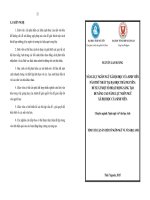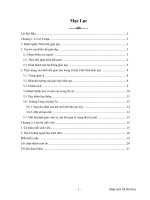TIỂU LUẬN NGÔN NGỮ XÃ HỘI HỌC
Bạn đang xem bản rút gọn của tài liệu. Xem và tải ngay bản đầy đủ của tài liệu tại đây (112.03 KB, 5 trang )
HUE UNIVERSITY
INSTITUTE OF OPEN EDUCATION
AND INFORMATION TECHNOLOGY
ENGLISH LANGUAGE
--------o0o--------
SOCIOLINGUISTIC PROJECT
Lecturer:
Trần Thuần
Student’s name:
Hiếu
Nguyễn Thị Minh
Student’s code:
7052900523
Class:
Nghệ An 6
Nghe An, July 2023
1
Topic 12: If more polite utterances tend to be longer than less polite ones, how
do you account for the fact that people who live and work very closely with
each other often communicate effectively (and politely) with very few words?
Refer to the concept of ‘phatic communication’.
Title: Phatic Communication: The Art of Effective Politeness in
Minimalism
Politeness plays a vital role in our daily interactions, often associated with
lengthy utterances that convey respect and formality. However, in cases where
individuals live and work closely with one another, it is intriguing to observe
how effective and polite communication can be achieved using minimal words.
This essay aims to explore the concept of 'phatic communication' and delve
deeper into how it enables efficient and polite conversations in close-knit
relationships.
1. Defining Phatic Communication:
2.
Phatic communication can be defined as the use of language to maintain social
bonds and communication, without necessarily conveying substantial
information. It focuses on establishing and preserving relationships, rather than
solely delivering factual content. In close relationships such as between family
members, friends, or coworkers, phatic communication becomes crucial for
facilitating effective interactions and fostering a supportive environment.
2. Minimalist Politeness:
Contrary to the common perception that polite utterances are inherently longer,
minimalist politeness brings forth a different perspective. In close relationships,
where individuals share a deep understanding of one another, communication
can be efficient and polite even with minimal words. This concept challenges
the notion that verbosity equates to politeness. Rather, minimalist politeness
relies on shared context, non-verbal cues, and implicit understandings to
effectively convey politeness and maintain interpersonal harmony.
2
3. Non-verbal Communication:
One of the reasons close people who don't talk much can still be polite and
wasteful with the help of nonverbal communication.
Nonverbal communication plays many important roles in intercultural problem
solving. When messages are sent in the linguistic channel conveying the literal
meaning and content of the word, the non-verbal channel is relied upon to carry
the slow flow of constraints that recognize the identity and relational meaning.
Occurring with or without verbal communication, nonverbal cues provide
warning to interpret and understand verbal messages. As such, we may create
confusion or confusion. Often, however, we can create conflict and mutual
understanding between cultures for three main reasons. First, a single nonverbal
signal can have different meanings and expressions in different cultures;
second, multiple nonverbal signals are sent simultaneously; and third, a high
degree of display rules should be considered, such as variations in gender,
Nonverbal messages are generally the primary means of communicating our
feelings, attitudes, and relationships with others, and we rely on nonverbal cues
to "say" things that are difficult to pronounce. Looking away when a person
tries to make eye contact with you can be interpreted in a myriad of ways, from
"I'm too busy" to "I don't want to talk to you" or "I'm embarrassed."
Nonverbal cues are defined as those messages embedded in nonverbal and
nonverbal signals that can be displayed through multiple communication
channels in a particular social environment. Nonverbal cues can be eye contact,
smiles, touch, hand gestures, or silence.
Paralinguistic is in your voice and can be speed, volume, timbre, or pitch.
Multichannel means that nonverbal signals are sent through multiple channels at
once, such as eye contact, facial expressions, and mechanical movements. The
sociocultural environment reflects the importance of print and our cultural
expectations in assessing the appropriateness and inappropriateness of a
nonverbal message.
Non-verbal cues play a significant role in enhancing communication efficiency
and reinforcing politeness within close relationships. Facial expressions,
3
gestures, and body language often complement and enrich minimal verbal
exchanges. These non-verbal cues provide an additional layer of meaning,
enabling individuals to communicate concisely while still preserving the
politeness and emotional nuances within the interaction.
4. Shared Experiences and Context:
The existence of shared experiences and context within close relationships
facilitates effective communication with minimal words. Over time, individuals
develop a deep understanding of each other's preferences, beliefs, and ongoing
experiences. This understanding allows them to anticipate each other's needs
and respond thoughtfully in a concise manner. Moreover, shared context
promotes the use of shorthand references, promoting efficiency and avoiding
lengthy explanations.
5. Tacit understanding and mutual respect:
Close relationships promote tacit understanding and mutual respect, which
further aids communication in minimal words. When you know the situation,
and understand the other person, communication becomes easier without having
to specifically cover the whole story to understand what the other person is
saying. Spending significant time together helps develop an intuitive sense of
each other's views and feelings. Know the circumstances and things that are
right for the other person, the insurmountable limits when communicating with
that person. As a result, individuals can assess the appropriate level of
politeness required in a given situation, minimizing the need for explicit verbal
politeness.
6. Emotional Intelligence and Adaptability:
Effective communication in close relationships also relies on emotional
intelligence and adaptability. People with a high emotional index will easily
understand their emotions in different situations. At the same time, they will
also understand what others say and express and know the impact of their
4
personal emotions on those around them. In addition, emotional intelligence
also helps people to have a good understanding of the emotions of others, so
that it is easier to connect and maintain strong, long-term relationships.
Therefore, when they can empathize and be well aware of the emotions of
others, they will easily find ways to behave, communicate and connect better
with people around them. For example, when you know that someone is
grieving and tired, you will gradually give them an appropriate response, giving
them attention, comfort, sharing and spiritual encouragement.
In addition, the empathy factor also helps a lot in building relationships. You
will learn how not to affect the other person's feelings, not to cause unnecessary
conflicts and disputes, and to create a healthy, positive connection environment.
Through observation and understanding, individuals can adjust their
communication styles, preferences and sensitivities to maintain politeness. This
adaptive approach demonstrates sensitivity to each other's needs, feelings, and
communication patterns, allowing for more efficient and polite interactions
using fewer words.
Close relationships offer a unique context where effective and polite
communication can be achieved with minimal words, contrary to the
assumption that politeness requires lengthy expressions. Phatic communication,
supplemented by non-verbal cues, shared experiences, implicit understandings,
and emotional intelligence, lays the foundation for concise yet respectful
exchanges within these relationships. By recognizing the significance of phatic
communication, we gain a deeper understanding of the dynamics involved in
interpersonal interactions, appreciating how language adapts and evolves in
familiar and contextual settings.
5









